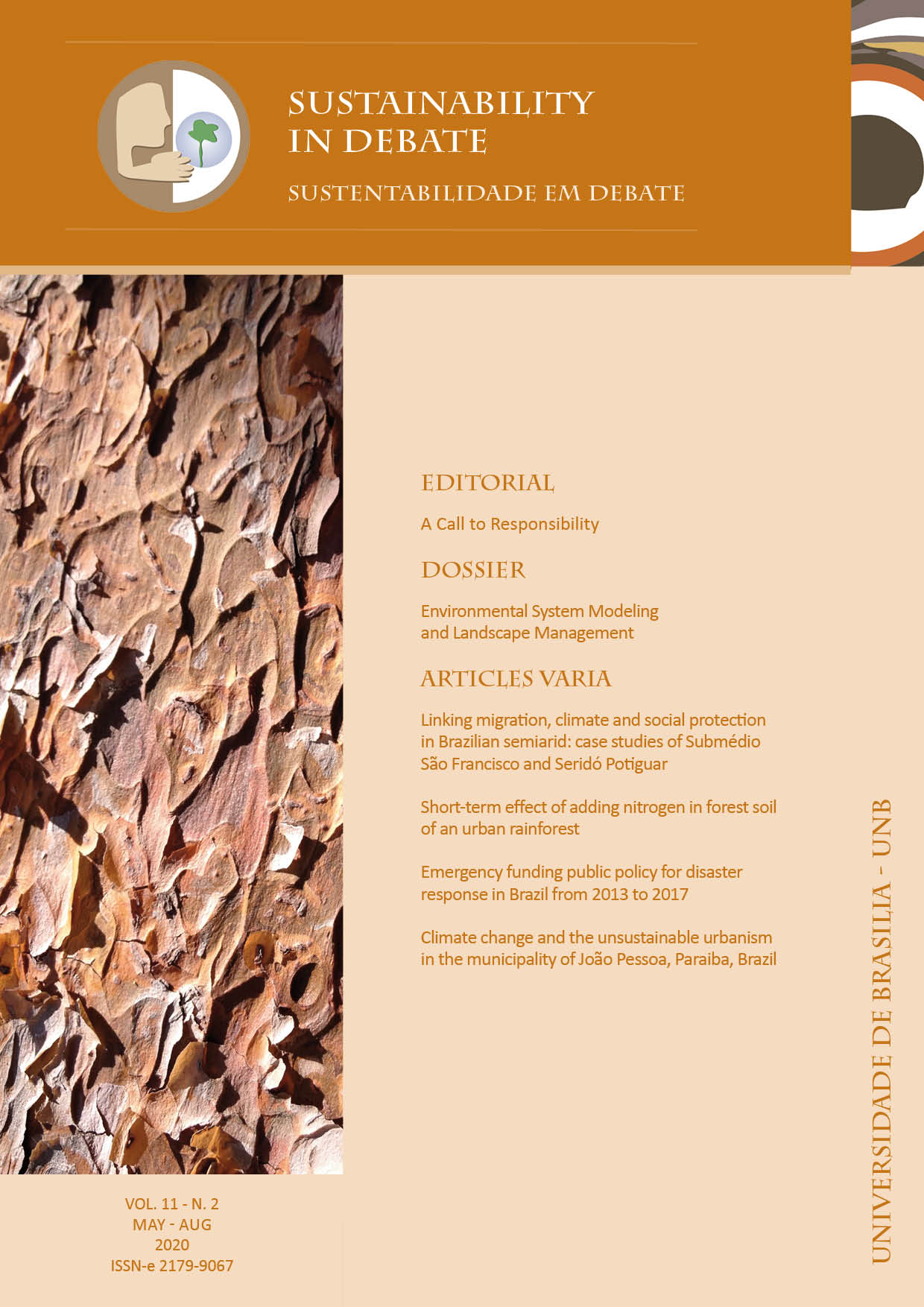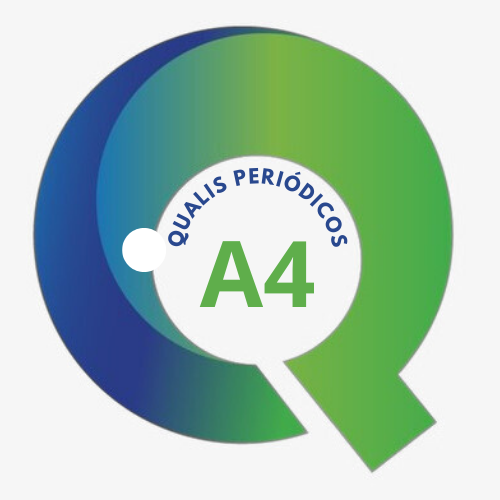Emergency funding public policy for disaster response in Brazil from 2013 to 2017
DOI :
https://doi.org/10.18472/SustDeb.v11n2.2020.31268Résumé
As políticas públicas de auxílio financeiro para ações de resposta a desastres são um tema pouco estudado. Neste artigo analisaram-se informações extraídas das bases de dados dos decretos de Situação de Emergência e Estado de Calamidade Pública e dos custos de socorro e resposta a desastres no Brasil, no período 2013-2017, a partir de suas distribuições espaço-temporal. Os custos de socorro e resposta a desastres são também utilizados em uma análise cruzada com indicadores municipais, como o Índice de Desenvolvimento Humano (IDHM) e o Produto Interno Bruto (PIB) per capita. Identificou-se que os gastos excederam R$ 800 milhões. As defesas civis estaduais responderam pela maior parte dos recursos utilizados (76,4%). Em um universo de 564 municípios que utilizaram o auxílio financeiro via Cartão de Pagamento de Defesa Civil, constatou-se a concentração de 40% dos recursos em 30 defesas civis municipais, algumas das quais em municípios com alto IDHM e PIB per capita.
Références
BANCO MUNDIAL. Avaliação de Perdas e Danos: inundações bruscas em Santa Catarina ”“ novembro de 2008. Brasília: Banco Mundial, 2012a.
BANCO MUNDIAL. Avaliação de Perdas e Danos: inundações bruscas em Pernambuco ”“ junho de 2010. Brasília: Banco Mundial, 2012b.
BANCO MUNDIAL. Avaliação de Perdas e Danos: inundações e deslizamentos na Região Serrana do Rio de Janeiro ”“ janeiro de 2011. Brasília: Banco Mundial, 2012c.
BRASIL. Instrução Normativa nº 02, de 20 de dezembro de 2016. 2016. Disponível em: <https://www.mdr.gov.br/images/stories/ArquivosDefesaCivil/ArquivosPDF/legislacao/Anexo-VI---Conceitos.pdf>. Acesso em: 17 jan. 2019.
BRASIL. Ministério da Integração Nacional. Módulo de formação: resposta, gestão de desastres, decretação e reconhecimento federal e gestão de recursos federais em proteção e defesa civil para resposta. Apostila do instrutor. Brasília-DF, 2017. Disponível em: <https://www.mdr.gov.br/images/stories/ArquivosDefesaCivil/ArquivosPDF/publicacoes/II---Resposta---Livro-Base.pdf>. Acesso em: 17 jan. 2019.
BRASIL. Política Nacional de Defesa Civil. Brasília: Sedec, 2007.
CARVALHO, D. W. Desastres ambientais e sua regulação jurídica: deveres de prevenção, resposta e compensação ambiental. 2. ed. São Paulo: Thomson Reuters, 2020.
CARVALHO, J. M. Cidadania no Brasil: o longo caminho. Rio de Janeiro: Civilização Brasileira, 2002.
CASTRO, A. L. C. Glossário de Defesa Civil: estudos de riscos e medicina de desastres. 5. ed. Brasília: Sedec, 2004.
CHAMBERS, R. Vulnerability, coping and policy. IDS bulletin, v. 20, n. 2, p. 1-7, 1989.
INSTITUTO BRASILEIRO DE GEOGRAFIA E ESTATÃSTICA. PIB per capita [2017]. IBGE Cidades. 2017. Disponível em: <https://cidades.ibge.gov.br/>. Acesso em: 17 jan. 2019.
KELLETT, J.; CARAVANI, A.; PICHON, F. Financing Disaster Risk Reduction: towards a coherent and comprehensive approach. 2014. Disponível em: <https://www.odi.org/sites/odi.org.uk/files/odi-assets/publications-opinion-files/9027.pdf>. Acesso em: 07 jul. 2019.
MARCHEZINI, V. Campos de desabrigados: a continuidade do desastre. São Carlos: RiMa, 2014.
MARCHEZINI, V.; SARTORI, J.; GONÇALVES, J. C. Desenvolvimento, Desastres e Reconstrução: o caso de São Luiz do Paraitinga/SP, Brasil. Revista Brasileira de Gestão e Desenvolvimento Regional, v. 13, p. 202-226, 2017.
PROGRAMA DAS NAÇÕES UNIDAS PARA O DESENVOLVIMENTO. Atlas do Desenvolvimento Humano no Brasil 2013. Disponível em: <https://www.br.undp.org/content/brazil/pt/home/idh0/rankings/idhm-municipios-2010.html>. Acesso em: 15 jan. 2019.
PROGRAMA DAS NAÇÕES UNIDAS PARA O DESENVOLVIMENTO. O que é o IDH. Brasília: Pnud, 2020. Disponível em: <https://www.br.undp.org/content/brazil/pt/home/idh0/conceitos/o-que-e-o-idh.html>. Acesso em: 10 jul. 2020.
TIERNEY, K. Disaster governance: social, political, and economic dimensions. Annual Review of Environment and Resources, v. 37, p. 341-363. 2012.
UNITED NATIONS DEVELOPMENT PROGRAM. Human Development Report 2019. Beyond income, beyond averages, beyond today: inequalities in human development in the 21st century. New York: UNDP, 2019. Disponível em: <http://hdr.undp.org/sites/default/files/hdr2019.pdf>. Acesso em: 05 jul. 2020.
UNITED NATIONS INTERNATIONAL STRATEGY FOR DISASTER REDUCTION. Global Assessment Report on Disaster Risk Reduction: making development sustainable. The Future of Disaster Risk Reduction, UN, New York, 2015.
VALENCIO, N. F. L. S. Desastres no Brasil: a face hídrica do antidesenvolvimento. In: VALENCIO, N. F. L. S.; SIENA, M. Sociologia dos Desastres: construção, interfaces e perspectivas. Volume IV. São Carlos: Rima Editora, 2014. p. 109-148.
VIEIRA, R. M. S. P. et al. Characterizing spatio-temporal patterns of social vulnerability to droughts, degradation and desertification in the Brazilian northeast. Environmental and Sustainability Indicators, 2020.
WALLEMACQ, P.; HOUSE, R. Economic Losses, Poverty & Disasters. 2018. Disponível em: <https://www.preventionweb.net/files/61119_credeconomiclosses.pdf>. Acesso em: 1 ago. 2019.
WILCHES-CHAUX, G. La vulnerabilidad global. In: MASKREY, A. (Org.). Los desastres no son naturales, 1993, p. 11-41. LA RED: Panamá.
WISNER, B.; GAILLARD, J. C.; KELMAN, I. Framing disaster: theories and stories seeking to understand hazards, vulnerability and risk. In: ______. The Routledge handbook of hazards and disaster risk reduction. p.18-34. London: Routledge, 2012.
Téléchargements
Publié
Numéro
Rubrique
Licence
© Sustentabilidade em Debate 2020

Cette œuvre est sous licence Creative Commons Attribution - Pas d'Utilisation Commerciale - Pas de Modification 4.0 International.
SUSTAINABILITY IN DEBATE – Copyright Statement
The submission of original scientific work(s) by the authors, as the copyright holders of the text(s) sent to the journal, under the terms of Law 9.610/98, implies in the concession of copyrights of printed and/or digital publication to the Sustainability in Debate Journal of the article(s) approved for publication purposes, in a single issue of the journal. Furthermore, approved scientific work(s) will be released without any charge, or any kind of copyright reimbursement, through the journal’s website, for reading, printing and/or downloading of the text file, from the date of acceptance for publication purposes. Therefore, the authors, when submitting the article (s) to the journal, and gratuitous assignment of copyrights related to the submitted scientific work, are fully aware that they will not be remunerated for the publication of the article(s) in the journal.
The Sustainability in Debate Journal is licensed under Creative Commons License – Non-Commercial-No-Derivation Attribution (Derivative Work Ban) 3.0 Brazil, aiming at dissemination of scientific knowledge, as indicated on the journal's website, which allows the text to be shared, and be recognized in regards to its authorship and original publication in this journal.
Authors are allowed to sign additional contracts separately, for non-exclusive distribution of the works published in the Sustainability in Debate Journal (for example, in a book chapter), provided that it is expressed the texts were originally published in this journal. Authors are allowed and encouraged to publish and distribute their text online, following publication in Sustainability in Debate (e.g. in institutional repositories or their personal pages). The authors expressly agree to the terms of this Copyright Statement, which will be applied following the submission and publishing by this journal.









